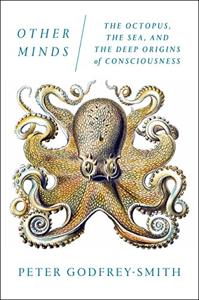
Want to learn the ideas in Other Minds better than ever? Read the world’s #1 book summary of Other Minds by Peter Godfrey-Smith here.
Read a brief 1-Page Summary or watch video summaries curated by our expert team. Note: this book guide is not affiliated with or endorsed by the publisher or author, and we always encourage you to purchase and read the full book.
Video Summaries of Other Minds
We’ve scoured the Internet for the very best videos on Other Minds, from high-quality videos summaries to interviews or commentary by Peter Godfrey-Smith.
1-Page Summary of Other Minds
Introduction
It’s different to meet an invertebrate than it is to meet other animals. People who have had the experience of encountering octopuses, cuttlefish or squid will tell you that they’re engaging and fun creatures.
Octopuses may wrap an arm or two around your hand and stare at you while feeling the texture of it. Cuttlefish may not touch you, but they watch closely and with interest.
The history of animals is described as a tree. All animals came from one single creature, the trunk, billions of years ago. As time went on, this creature evolved into new animals which then split off into many different branches. Some died out and their branches abruptly stopped growing.
Vertebrates and invertebrates branched off from each other at one point. Cephalopods are unique because they’re invertebrates but have large nervous systems like ours. They evolved separately, just like we did. However, cephalopods are also complex creatures that have their own story to tell.
A History of Animals
The Earth is billions of years old and for much of that time, organisms existed in the form of single-celled organisms. These organisms lived in the sea and they were able to sense what was going on around them. They sensed food sources, toxic chemicals, and other organisms around them.
As multicellular creatures evolved, they had to work together as a larger whole. The sense and perception capabilities that they used in their individual lives were now used in coordination with one another.
The nervous system is responsible for coordinating all the body’s different abilities. It evolved from cells that were able to coordinate their actions with one another. The nervous system contains neurons, which spray chemicals at one another and trigger action in other cells by triggering a response. This coordination of the body’s ability to respond to stimuli helps animals move around and do things more effectively than single-celled organisms could do before.
The Cambrian Period began roughly 542 million years ago, and it saw the appearance of many new animals. Fossils from before that time indicate that early animals rarely interacted with each other. They had no claws or armor, which means there was little predation going on. However, this changed in the Cambrian Period when more complex animals appeared on Earth. Animals began to have eyes, claws, antennae and other parts suggesting predation for the first time in history. For the first time ever, minds and bodies evolved in response to other minds and bodies
The nervous system also evolved, and it’s possible that its original purpose was to help the animal move. Later on, however, animals needed a way to respond to their environment in order to find food and avoid predators.
During the Ediacaran Period, there was a significant split in the evolutionary tree of life. One branch led to vertebrates and fish, while another branch led to invertebrates like insects and crustaceans.
We shared a common ancestor with octopuses, squid, and cuttlefish at some point.
Mischief and Craft
Cephalopods are invertebrates that have large nervous systems. They developed shells to deal with the new predatory lifestyle of the Cambrian Period, which was a long time ago. For a long time they lived under their shells and used one foot to crawl along the seafloor. Eventually they evolved into predators rather than prey, and eventually their shells disappeared completely, giving them endless possibilities for evolution.
Cephalopods evolved. Some of them became intelligent, although that intelligence is difficult to measure because they are so different from mammals.






